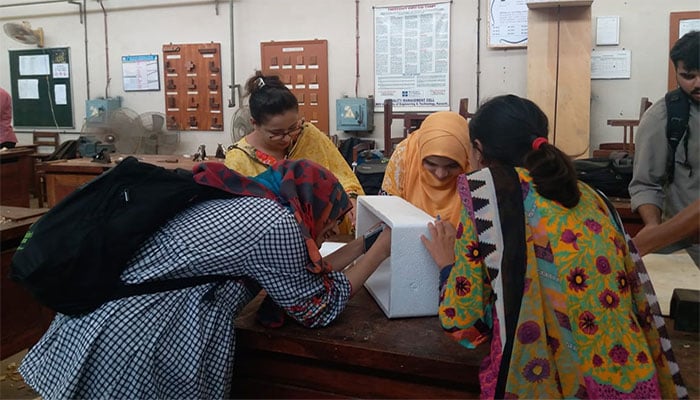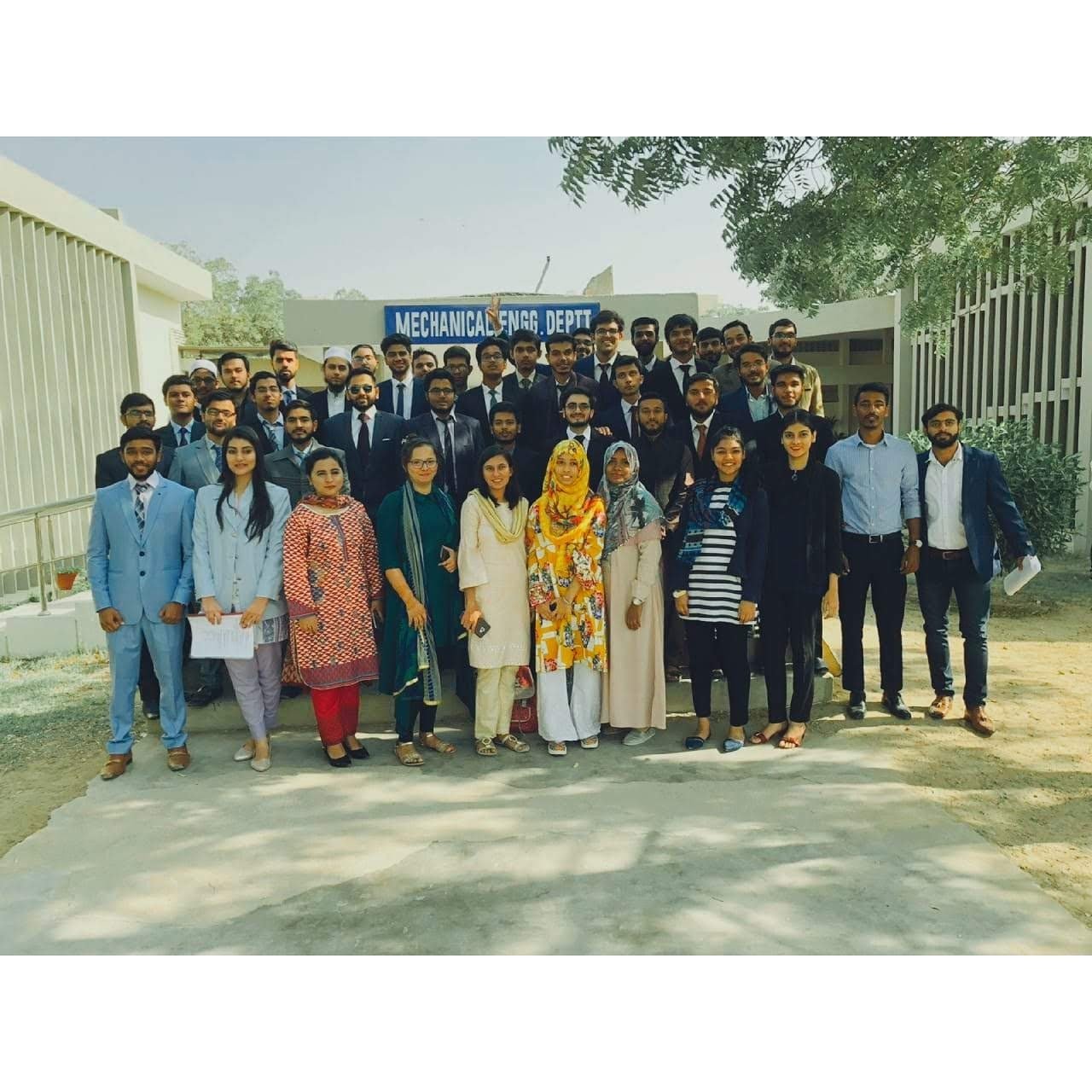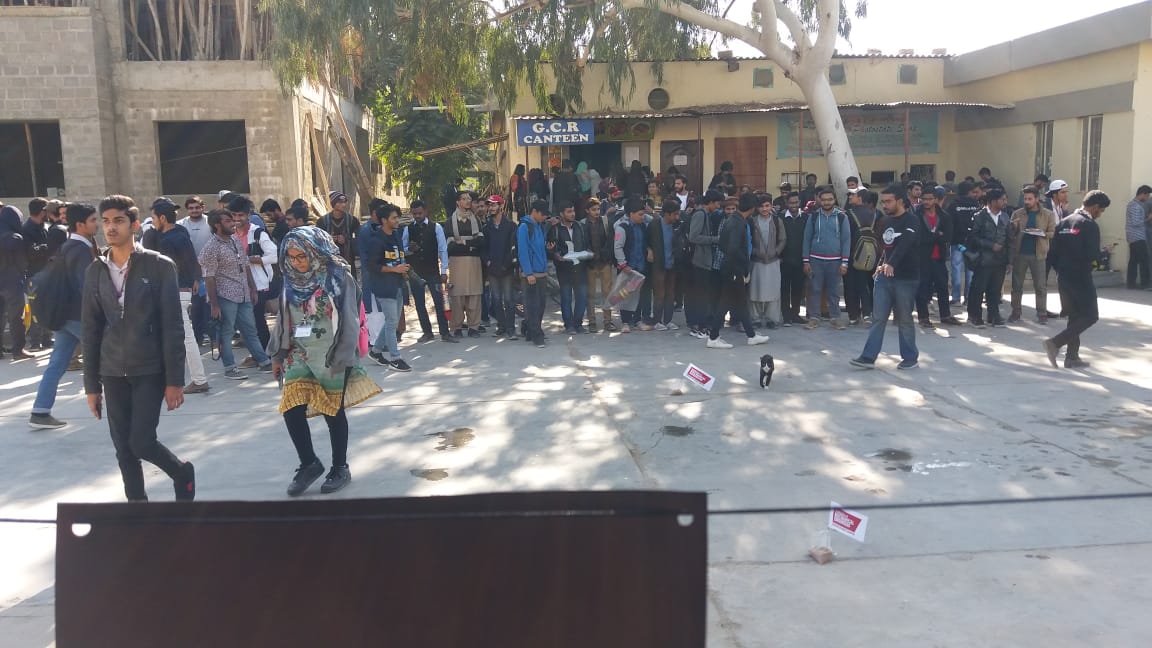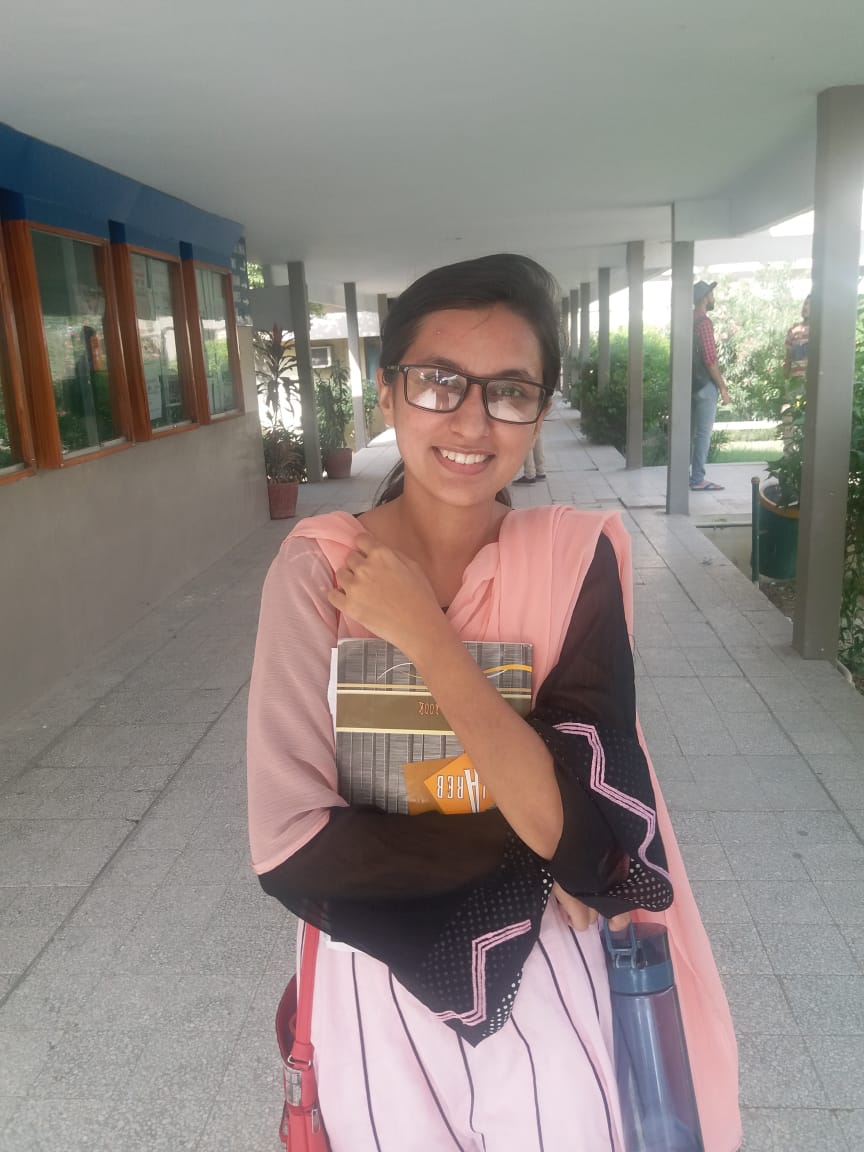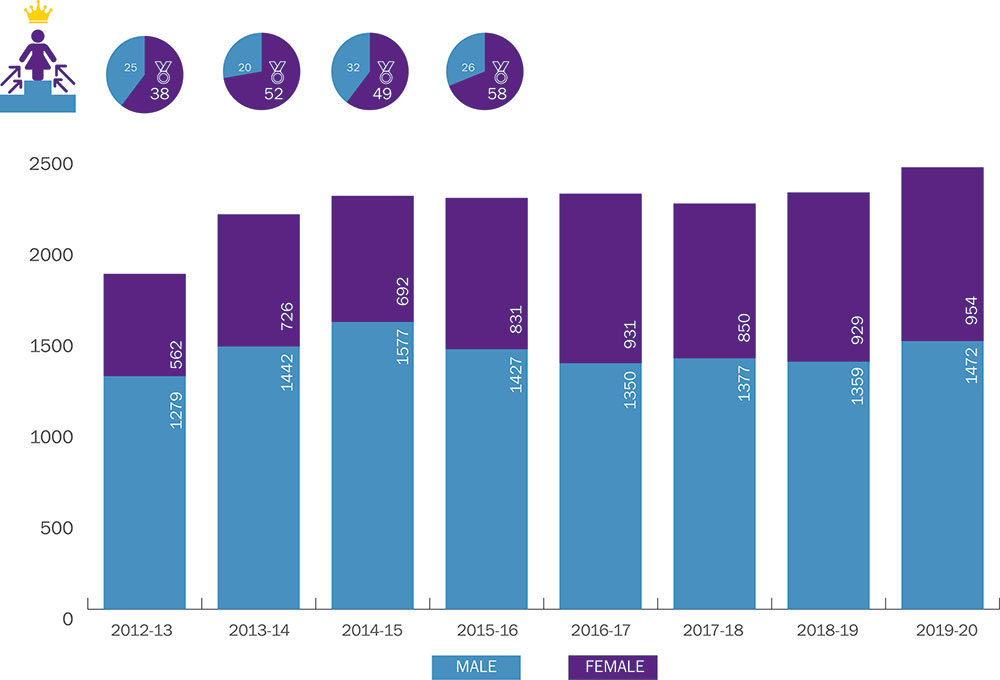NED University’s female engineers show women of Karachi excelling in engineering
Ume Soolaim — a student of the final year at the NED University of Engineering and Technology’s mechanical engineering department — intends to practise her theoretical understanding of mechanical engineering by entering the professional filed after her graduation this year.
She, however, is fully aware of the fact that very few women engineers survive in the professional field, but this does not hold her back as she is committed to making a contribution to the local mechanical industry and playing her part to ensure that there is a good representation of women in the field so that the female engineers of the future do not hesitate to join the industry.
The department of mechanical engineering where she studies has a little number of female students. The six sections of the final year comprise 50 students each but the total number of girls in all the sections is just 10.
Ume Soolaim secured her admission to the mechanical engineering department in 2016. She recalled that in her initial days at the varsity, she would wait for long for any other girl student to come so that she could accompany her in the classes. It took some days for her to realise that female students in the department were very under-represented and only a few girls had been able to secure admissions to the mechanical engineering department.
“I have no regret for studying mechanical engineering. I also know that very few women engineers survive in the professional field,” she said, adding that only the girls could change the trend by daring to enter the male-dominated engineering fields.
Earlier this year, when the varsity sent her for an internship, she was the only girl in a group of 25 students who completed internships in the Karachi Shipyard & Engineering Works and another private company. “In a society like ours, people generally believe that girls are not fitted for the fields of engineering and sciences. But the real problem is that neither do female students show interest in breaking the trend nor do the parents encourage their daughters to pursue engineering education to control the gender disparity in the field.”
She believes that the parents are to blame for in many cases when girls despite their interest are not able to pursue the engineering field. Parents suggest to their daughters that they should study other fields instead of engineering, which has been constantly increasing the gender gap in the engineering fields, she said.
Gender data of NED
The data of the NED University, which is one of the largest engineering varsities of Pakistan, shows that the female students have little representation in many engineering departments including those of civil engineering, automotive engineering, electronics engineering and electrical engineering.
However, the most significant trend that the data shows is that the overall number of female students has been increasing for the last many academic years at many other departments of the varsity.
Talking about the stereotyping about the girls who study engineering, Sareem Siddiqui, a student of the final year at the automotive engineering department said: “If females don’t give preference to study engineering, how one could expect that women would have enough representation in the professional fields of engineering.”
She said that recently the varsity sent her for an internship to the Pakistan International Airlines’ maintenance department where she observed that no woman engineer was working there apart from her. The ratio of female students in her class is also significantly less than the boys as of the 52 students in the class, only four are female.
“This is not about men's domination in the fields of engineering. But females have to accept challenges if they want to overcome the gender disparity in the field of science and technology,” said Sareem, illustrating that a few years back, women would rarely join the media industry but the trend had reversed now as these days it seemed that women journalists were more in number than men.
Likewise, she said the number of working women engineers could also be improved, but many women who completed engineering degrees chose to stay at homes or even if they joined the profession, they tended to quit it after sometimes. Also, a lack of jobs in the engineering industry further discouraged the women and restricted space for them in the professional fields, she added.
The computer engineering is the only department of the NED University where more girls have secured admissions than boys. Following this trend, Sareem initially got admission to the computer engineering department but later she switched to the automotive engineering. “I changed my decision because even if I study Islamic Studies, as a working woman I would have to face men. So why should I study the subject in which I have no interest,” she remarked.
She pointed out that generally people in our society believed that women were not suitable for the engineering fields. Due to misconceptions about the role of engineers, people believe that the engineers are supposed to do jobs involving machinery that required intensive labour, she said and clarified that what the engineers do is giving instructions to the technicians, building designs and coming up with new innovations –all of which do not require any labour and hence, the nature of the job is convenient for both the genders.
Increasing numbers
Contrary to the impression that women are not apt to study engineering that also gets support from the fact that they are under-represented at the NED University, the fact is that during the last 10 years, the number of female engineering students has increased in every year.
In the session year 2012-13, as many as 1,841 students had secured admissions to various departments for the bachelor’s programme at the NED University, of whom only 562 were girls. In the next year, however, 726 of the total 2,168 new students were female. Likewise, in the academic year 2015-16, the number of female students rose to 831, while in the current academic year, 954 girls secured admissions to various engineering departments of the NED University.
Another interesting trend the data shows is that the female students have bagged more top positions than male students in the last four graduated batches. Of those who got admissions to the varsity in 2012-13, 63 were honoured in the annual convocation for clinching top positions after their four-year education. Of them, 38 were girls.
The number of the position holder students in the batch that got admissions in 2013-14 was 72, of whom 52 were female.
Similarly, 81 graduates, including 49 female students, completed their studies with distinctions in 2018. In the latest graduated batch, of the 84 position holder students, 58 were female.
Discussing the problems faced by female students in engineering education, NED University Registrar Syed Ghazanfar Hussain said officials of the NED University were striving hard to attract more talented students regardless of gender biases. Keeping transparency in the admission processes, the varsity conducts an entrance test to award admissions on merit, he said.
The registrar added that compared to girls, more boys attempted the NED University’s entrance test, but the success ratio of girls was always higher than that of boys in every test.
He explained that female students from diverse neighbourhoods had been showing interest in studying engineering. This is why in the recent academic years, the varsity received a large number of admission applications from female students. The latest admission trends of the NED University show that 40 per cent population of the varsity are female but despite being a minority, they comprise 65 percent of the position holder students.
The NED University is closely working with the industry, government organisations and private firms to provide maximum job opportunities to its students, the registrar said, adding that the women engineers would soon overcome the gender disparity in the professional field.
Lack of unions
When it comes to the national level about the participation of women engineers in the fields of science, technology, engineering and mathematics (STEM), one can hardly name a few renowned women engineers of the country.
There are also no statistics available with any organisation showing how many women are working in various fields of engineering in Pakistan. Likewise, there is also a lack of organisations, associations, and unions working for the wellbeing of women engineers.
However, an origination named Women Engineers Pakistan (WEP) on its website has written that the vision of the organisation is to bridge the gender gap within the STEM domains in Pakistan. The website further reads that the WEP through its campus ambassador and mentorship programmes strives to increase the representation of women in engineering by encouraging the notion of diversity.
The WEP also intends to motivate younger female generation to pursue engineering by highlighting the success of women in engineering and technology.
Despite the lofty vision of the WEP, its website reveals that it is working only in eight cities. It has access to only 15 varsities while the entire network comprises 1,033 professional women. The outreach of the organisation is limited to only 4,000 schoolchildren.
Performance is solution
Discussing issues being faced by the working women engineers, Prof Dr Anila Naeem, the chairperson of the NED University architecture and planning department, said the women engineers hardly found female mentors for guidance and learning the required skills in the engineering profession.
She denied the stereotype that girls do not have the same level of interest in engineering as boys. “If we examine the data of the intermediate boards of Sindh, it shows the female students bring good results than boys in the pre-engineering exams. Thus, in the last several years, a large number of girls have entered various fields of engineering and STEM. However, there is still a need to encourage girls on the school and college levels for choosing to study engineering fields,” she said.
She, however, was of the view that sometimes it was difficult to bifurcate the workforce of an organisation on a gender basis. It is not a solution to isolate women engineers of an organisation because it would restrict learning opportunities for them. Therefore, the women engineers needed to work within the existing framework with confidence and full devotion for getting equal representation in the field, she said.
About the lack of associations of women engineers, she opined that there was no need for gender-based struggle but if the women engineers excelled in their work, it would eventfully result in many young women joining the field.
As much good work the women engineers performed, as much difficulties they will overcome at their workplaces, she said.
-
 Japan Unveils Anti-ship Missile With ‘barrel-roll’ Evasion To Outsmart Defenses
Japan Unveils Anti-ship Missile With ‘barrel-roll’ Evasion To Outsmart Defenses -
 How Brooklyn Beckham 'mentor' Prince Harry Inspiring Him To Speak Against Family?
How Brooklyn Beckham 'mentor' Prince Harry Inspiring Him To Speak Against Family? -
 Zac Efron, Kenny Ortega Revisit 'High School Musical' After 2 Decades
Zac Efron, Kenny Ortega Revisit 'High School Musical' After 2 Decades -
 Threads Overtakes X On Mobile Users: Here’s Why Everyone’s Switching
Threads Overtakes X On Mobile Users: Here’s Why Everyone’s Switching -
 Kanye West Eyes Performing First-ever Concert In India
Kanye West Eyes Performing First-ever Concert In India -
 Brooklyn Beckham's Claim About Nicola's Wedding Ordeal Gets Challenged
Brooklyn Beckham's Claim About Nicola's Wedding Ordeal Gets Challenged -
 AI Horror: 4 In 5 Young Workers Fear 'AI Could Replace Their Jobs', Says Report
AI Horror: 4 In 5 Young Workers Fear 'AI Could Replace Their Jobs', Says Report -
 Missouri Couple ‘locked Sons In Chicken Pen, Shot Them’ In Shocking Abuse Case
Missouri Couple ‘locked Sons In Chicken Pen, Shot Them’ In Shocking Abuse Case -
 King Charles Receives 'delightful' Royal Baby News
King Charles Receives 'delightful' Royal Baby News -
 Chinese ‘mega Embassy’ Wins UK Approval In London Ahead Of Starmer’s China Visit
Chinese ‘mega Embassy’ Wins UK Approval In London Ahead Of Starmer’s China Visit -
 David Beckham Gives Telling Reaction To Brooklyn’s Public Complaints
David Beckham Gives Telling Reaction To Brooklyn’s Public Complaints -
 Can Ibuprofen Cut Cancer Risks? Study Finds Promising Breakthrough
Can Ibuprofen Cut Cancer Risks? Study Finds Promising Breakthrough -
 Piers Morgan Finally Reacts To Brooklyn Beckham's Statement About David And Victoria Beckham
Piers Morgan Finally Reacts To Brooklyn Beckham's Statement About David And Victoria Beckham -
 Tom Hiddleston Reveals Unlikely DC Character That Inspired Loki
Tom Hiddleston Reveals Unlikely DC Character That Inspired Loki -
 Prince Harry, Meghan Markle Warned 2026 Will Be 'a Big Test' For Them
Prince Harry, Meghan Markle Warned 2026 Will Be 'a Big Test' For Them -
 OpenAI Plans First ChatGPT Device For 2026
OpenAI Plans First ChatGPT Device For 2026
